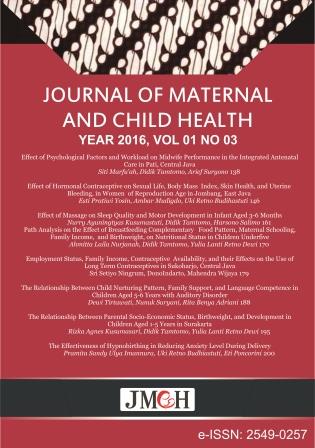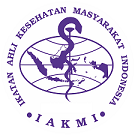Employment Status, Family Income, Contraceptive Availability, and their Effects on the Use of Long Term Contraceptives in Sukoharjo, Central Java
Abstract
Background: Rapid population growth cause population burden on earth and imbalance population distribution. This situation in turn make cause public health and social problems. One of the methods that can be used to control population growth is long term contraceptive use. The Indonesian Demographic and Health Survey (SDKI) showed that employed mothers were more likely to use long term contraceptive than unemployed mothers. Contraceptives are available for free at Family Planning Clinic (KKB). This study aimed to analyze the effect of employment status, family income, and contraceptive availability, on the use of long term contraceptive among women and men of reproductive age in Sukoharjo, Central Java.
Subjects and Method: This was a qualitative analytic and descriptive study with phenomenology approach. This study was conducted in Weru, Kartasura, Polokarto, and Tawangsari subdistricts, Sukoharjo, Central Java. The key informants included acceptors of implant, Intra Uterine Device (IUD), Female Surgical Method (MOW), and Male Surgical Method (MOP). The data were collected by in-depth interview, Focus Group Discussion (FGD), observation, document review. The data were alayze by interactive analysis. The data were verified by triangulation of data sources.
Results: Two informants reported they chose IUD because they had to work outside the house, undesirable side effects of using oral contraceptive, injection contraceptive, and contraceptive use by their mothers and grandmothers. Some other informants have used implant because of undesirable side effect of using injection contraceptive, such as irregular menstruation and increased body weight. Two other informants have used female surgical method (MOW) because they already have three children and do not want to be pregnant again. One male informant reported that he has used male surgical method (MOP) because already has four children, and he followed the methods his father has used. Most of the long term contaceptive users work outside the house and their incomes were lower than the minimum regional standard wage. Most of the long term contraceptive users receive free contraceptive and additional reward (e.g. free rice). The remaining long term contraceptive users buy contraceptives at the health center and hospital. The contraceptives were supplied by the National Coordinating Board of Population and Family Planning (Badan Kependudukan dan Keluarga Berencana Nasional, BKKBN) at province level. Village midwives did not receive free contraceptive because their practices have not been classified as Family Planning Clinics (KKB).
Conclusion: Availability of contraceptive is a necessary condition for long term contraceptive use. Working outside the house is an additional factor for most women to realize long term contraceptive use.
Keywords: Employment status, family income, availability, long term contraceptive
References
Affandi B (2011). Buku Panduan Praktis Pelayanan Kontrasepsi. Jakarta: PT. Bina Pustaka Sarwono Prawirohardjo
Asih L, Oesman H (2009). Faktor
Badan Pusat Statistik Indonesia (2015). Laju Pertumbuhan Penduduk Per Tahun Menurut Provinsi.
BKKBN (2014). Pedoman Penyelenggara Pelayanan Keluarga Berencana dalam Jaminan Kesehatan Nasional. Ja-karta: DITJALPEM BKKBN
(2015). Rencana Strategi Badan Kependudukan dan Keluarga Be-rencana Nasional Tahun 2015-2019. Jakarta: BKKBN
Badan Perencanaan Pembangunan Nasional (BPPN). (2014). Peraturan Pemerintah RI nomor 2 tahun 2015 Tentang Rencana Pembangunan jangka menengah nasional (RPJMN 2015 - 2019). Jakarta: Kementerian Kesehatan RI
Desa Jatingarang. (2012). Data Profil Desa dan Tingkat Perkembangan Desa. Sukoharjo
Desa Makamhaji. (2013). Data Profil Desa dan Tingkat Perkembangan Desa. Sukoharjo
Desa Mranggen (2013). Data Profil Desa dan Tingkat Perkembangan Desa. Sukoharjo
Desa Kedungjambal. (2013). Data Profil Desa dan Tingkat Perkembangan Desa. Sukoharjo
Dinas Kesehatan Kabupaten Sukoharjo (DKK Sukoharjo). (2014). Profil Kesehatan Kabupaten Sukoharjo. Sukoharjo: Dinas Kesehatan Kabupaten Sukoharjo
Getinet, Abdrahman, Kemaw, Kansa, Getachew, Hailu dan Workineh (2014) Long Acting Contraceptive Method Utilization and Associated Factors among Reproductive Age Women in Arba Minch Town, Ethiopia. Journal of Epidemioloogy and Public Health, 2 (1): 023-031
Gonzalez (2010). Comparison of Physical, Public and Human Assets as Determinants of Socioeconomic Inequalities in Contraceptive Use in Colombia Moving Beyond the Household Wealth Index. International Journal For Equity in Health, 9 (10)
Kementerian Kesehatan Republik Indonesia (2013). Buku Saku Pelayanan Kesehatan Ibu di Fasilitas Kesehatan Dasar dan Rujukan. Jakarta
_____ (2015). Rencana Strategis Kemen-terian Kesehatan Tahun 2015
_____ (2015). Profil Kesehatan Indonesia Tahun 2014. Jakarta
Nasution SL (2011). Faktor
Pujihastuty R, Winarni E (2011). Analisa Lanjut 2011: Pola Pembiayaan Pelayanan Kontrasepsi di Enam Provinsi di Indonesia dalam Rangka Evaluasi Kebijakan Alat dan Obat Kontrasepsi Gratis. Jakarta: PUSLITBANG KB dan KS BKKBN : 1-44.





